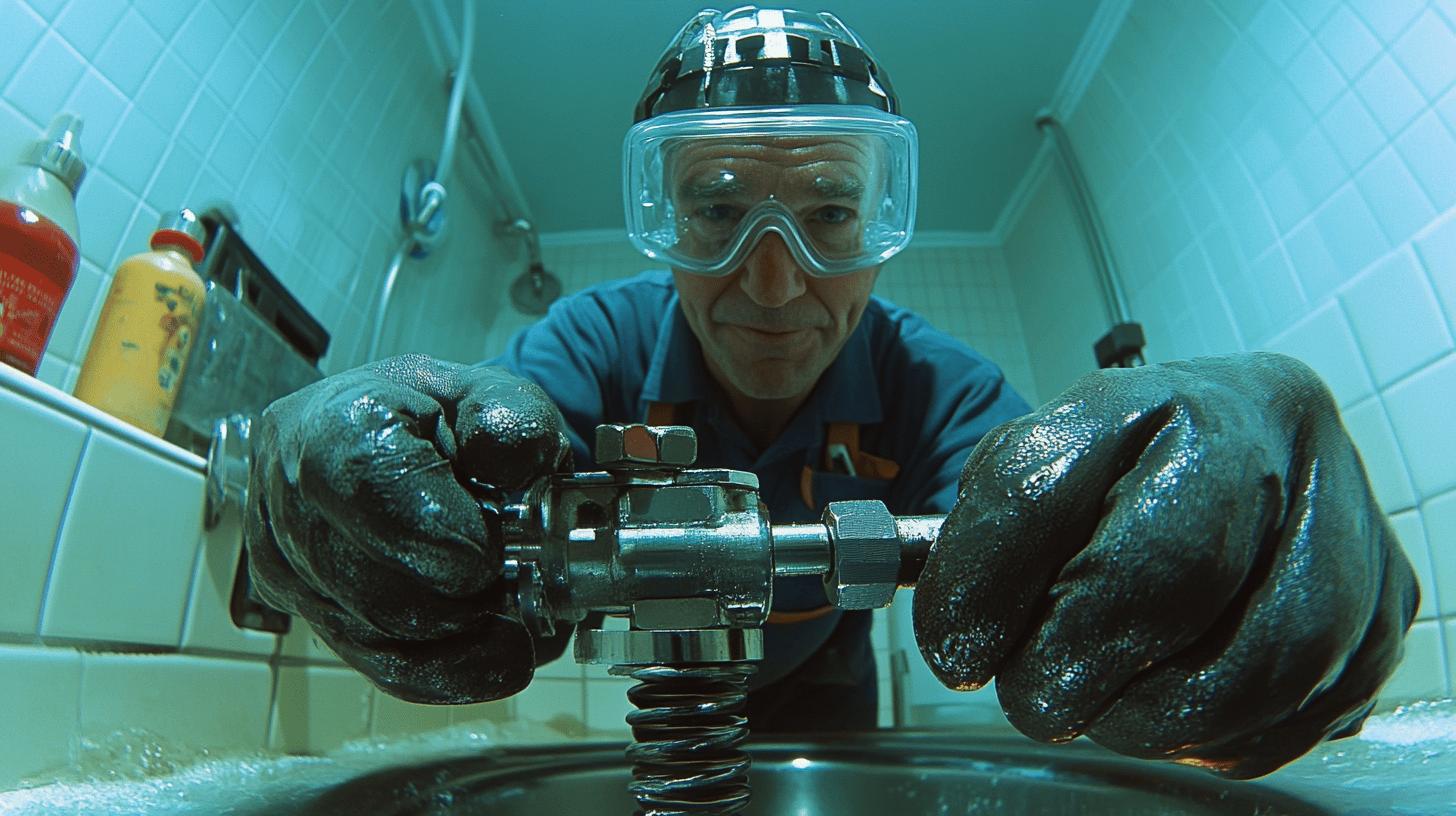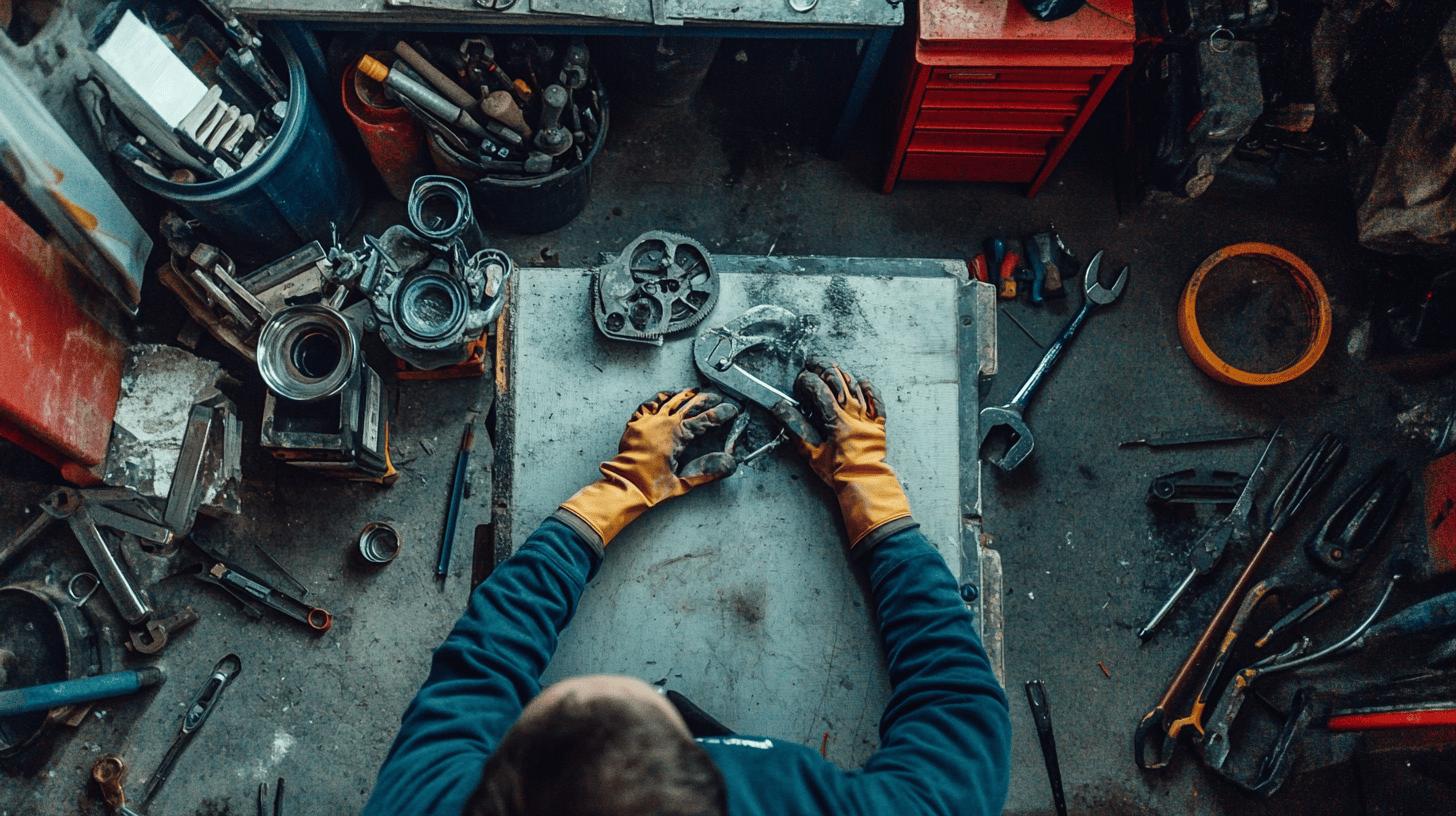TL;DR:
- Plumbing augers clear clogs beyond plungers, ideal for DIY cleaning.
- Key tips: Avoid excessive force, clean after use, wear gloves.
- Steps to use: Gather materials, insert auger, crank through clog, retract, and repeat if needed.
- Types of augers:
- Hand-crank: For minor clogs.
- Motorized: For severe clogs.
- Flat tape: For narrow pipes.
- Toilet auger: For toilets.
- Drum and electric augers: For tougher blockages or professional use.
- Preventive measures: Use strainers, flush with hot water, avoid grease, and clean and store the auger properly.
- Call professionals for persistent or deep clogs to avoid pipe damage.
Dealing with stubborn clogs that won’t budge no matter what you try? A plumbing auger, or drain snake, could be the solution. This flexible metal tool is built to handle tough blockages. Whether you’re new to using one or want to improve your skills, learning how to use a drain snake can save you time and frustration. This guide will teach you simple tips, help you avoid mistakes, and keep your pipes clog-free. Ready to level up your drain-cleaning game? Let’s get started!
Effective Plumbing Auger Tips for Beginners
A plumbing auger, or drain snake, is a must-have tool for clearing tough clogs in your drains. Its flexible metal cable reaches deep into pipes to handle blockages that plungers can’t fix, like hair in bathroom drains or food in kitchen sinks. It’s great for DIY drain cleaning, but using it correctly is key to avoiding damage. Learn how it works, and you’ll be on your way to mastering drain maintenance at home.
- Avoid excessive force to prevent pipe damage.
- Don’t leave the auger partially retracted to avoid tangling.
- Clean and dry the auger before storage to prevent rust.
- Don’t use a motorized auger on fragile pipes to avoid breakage.
- Wear protective gloves to prevent injuries.
Practicing with a plumbing auger makes clearing clogs easier and less stressful. Start with small blockages to get the hang of using it. With time, you’ll learn how to spot clogs and apply the right pressure. Being careful protects your pipes and boosts your confidence. If a clog won’t budge or you’re unsure, it’s smart to call a plumber to keep your system in good shape.
Step-by-Step Guide to Using a Plumbing Auger

- Insert it into the drain carefully.
- When you hit resistance, crank the handle to push it forward.
- Use the corkscrew tip to break up the clog.
- Pull it back slowly, removing debris as you go.
- Repeat if needed until the drain is clear.
Choosing the Right Plumbing Auger for Your Needs
Picking the right plumbing auger makes drain cleaning easier and safer. Each type is designed for specific clogs, so using the right tool is key. For small clogs in sinks or showers, a hand-crank auger works well—it’s simple and gentle on pipes. For tougher blockages, like tree roots in sewer lines, a motorized auger is better since it has more power and reach. Using the right auger avoids damage and gets the job done faster.
- Hand-crank auger: Great for small clogs in sinks and bathtubs.
- Motorized auger: Best for severe clogs and tree root intrusions.
- Flat tape auger: Useful for clearing narrow pipes.
- Toilet auger: Made specifically for unclogging toilets.
- Drum auger: Handy for home use with moderate clogs.
- Electric auger: Suitable for professional use on large, tough blockages.
For tough plumbing problems, like stubborn clogs or possible pipe damage, it’s best to call a professional plumber. They have the skills and tools to fix the issue without causing more harm. Plus, they can suggest the right type of auger for your situation. Getting expert help not only solves the current issue but also helps avoid future plumbing headaches.
Preventative Measures and Maintenance for Plumbing Augers

Taking care of your plumbing auger keeps it working well for longer. After using it, clean it with hot water and disinfectant to remove debris and germs. Make sure it’s completely dry before putting it away to avoid rust. Check for any damage or wear before storing it. Regular upkeep ensures your auger stays in top shape and ready for the next job.
- Install drain strainers to catch debris and prevent it from entering pipes.
- Avoid pouring grease or oil down the drain to reduce the risk of clogs.
- Regularly flush drains with hot water to keep them clear.
- Use baking soda and vinegar monthly to break down small blockages naturally.
Storing your plumbing auger the right way is just as important as keeping it clean. Keep it in a dry, cool spot to prevent rust. Coil the cable neatly to avoid kinks or damage. This simple care ensures your auger stays in good shape and ready for your next drain cleaning job.
Professional Plumbing Services: When to Call the Experts
DIY drain snaking works for small clogs, but it has its limits. Basic tools might not reach deep blockages, and using too much force can damage your pipes. Home tools are also less powerful than professional equipment, making them less effective for tough clogs. Know when to stop and call an expert.
For serious clogs or suspected pipe damage, it’s better to hire a plumber. They use advanced tools like motorized augers and cameras to clear blockages and find issues. Professionals save you time, money, and future plumbing headaches.
Final Words
Getting comfortable with plumbing augers starts by learning how to use them, picking the right tool, and keeping them in good shape. These tips help you avoid common mistakes and understand when to use each type of auger. While DIY snaking works for small clogs, serious blockages are best handled by professionals for safety and effectiveness.
Regular maintenance and proper storage keep your auger ready for the next task, ensuring it lasts longer. By combining DIY knowledge with professional advice, you’ll improve your plumbing skills and keep your system running smoothly. Embrace these tips for a hassle-free plumbing experience.
FAQ
Q: What are some tips for using a homemade plumbing auger?
A: To effectively use a homemade plumbing auger, ensure the cable is flexible and durable. Always insert it carefully into the drain, avoid excessive force, and retract it fully to prevent tangling.
Q: How can I use a drain snake for a toilet?
A: Use a toilet auger specifically designed with a flexible neck to navigate toilet curves. Insert gently, crank the handle to break up the clog, and withdraw slowly to clear obstructions.
Q: What is the best way to use a drain auger?
A: Insert the auger into the drain opening, rotate the handle to advance through the pipe, and repeatedly retract the auger to loosen and remove the clog fully.
Q: Why might my auger not be clearing the drain?
A: If an auger isn’t clearing a drain, check for cable kinks, ensure the tip isn’t blocked, and verify you’re applying steady pressure in the correct direction to reach the clog.
Q: How do you get a drain snake past a 90-degree elbow?
A: Apply consistent pressure with gentle twisting motions to navigate elbows. A flexible auger tip can assist in maneuvering turns without causing damage to the pipes.
Q: What is the difference between a drain snake and an auger?
A: A drain snake is typically for minor clogs, while an auger handles larger blockages. Augers are often more robust and may feature different mechanisms for various clog severity.

